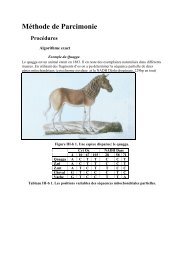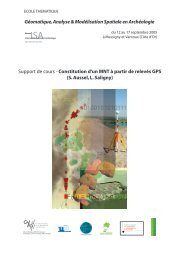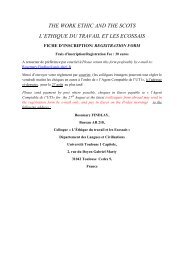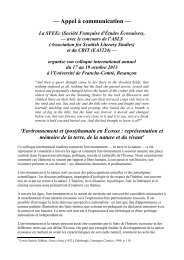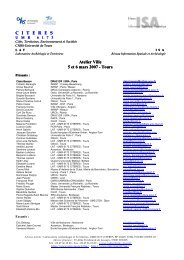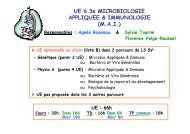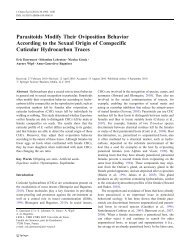Cours de JG. Breheret: « Microbes des profondeurs
Cours de JG. Breheret: « Microbes des profondeurs
Cours de JG. Breheret: « Microbes des profondeurs
- No tags were found...
You also want an ePaper? Increase the reach of your titles
YUMPU automatically turns print PDFs into web optimized ePapers that Google loves.
Les microbes :<strong>de</strong>s profon<strong>de</strong>urs du temps
1. ces microbes qui nous entourentdans les milieux naturels2. tapis microbiens en milieu littoral :<strong>de</strong> la vie à la roche3. <strong>de</strong>s extrêmophiles4. l!aube <strong>de</strong> la vie sur Terre : l!ère <strong>de</strong>s procaryotes5. la vie ailleurs ?
1. Ces microbes qui nous entourentdans les milieux naturelsBloom <strong>de</strong> Microcystis - Dayet Afourgagh (Moyen Atlas marocain)
<strong>Microbes</strong>Procaryotesbactéries (eubactéries)archées (archéobactéries)Eucaryotesmycètes (champignons)alguesprotozoaires
Plan <strong>de</strong> Phasy<strong>JG</strong>B
ProcaryotesHabitat nombre <strong>de</strong> cellules % du totalSous-sol marin 3,6.10 30 66Sous-sol terrestre 1,4.10 30 (0,25-2,5) 26Sol émergé 2,6.10 29 4,8Eau <strong>de</strong> mer 1,2.10 29 2,2Eau douce, lacs salés 2,3.10 26 0,0043Animaux domestiques 4,3.10 24 0,000080Glace polaire 4,0.10 24 0,000074Termites 6,5.10 23 0,000012Humains 3,9.10 23 0,0000072Oiseaux domestiques 2,4.10 21 0,000000044Nombre total = 5.10 30 cellules(soit env. 50.000 milliards <strong>de</strong> fois le nombre estimé d’étoiles dans l’Univers)Carbone procaryotique : 200 premiers mètres <strong>de</strong> l’océan : 0,72.10 9 tCellules procaryotiques : 350 à 550.10 9 t <strong>de</strong> C (poids sec : 700-1.100.10 9 t)Flore terrestre : 550.10 9 t <strong>de</strong> carbone
EUCARYOTESanimaux plantes champignonsflagellésciliésmyxomycètesmicrosporidiesARCHAEBACTERIESsulfolobalesthermoprotéalesThermophilescyanobactériesbactériesGram positifprotéobactériesEUBACTERIESspirochètesbactériesvertesthermotogalesflavobactériesthermococcaleshalobactériacéesméthanobactérialesMéthanogènesméthanomicrobialesHalophilesArbre du vivant d’après Carl Woese et al.(1990), fondé sur les comparaisons <strong>de</strong>sséquences <strong>de</strong> petites sous-unités d’ARN
www.las.uiuc.edu/.../ Images/carl_woese.jpgC. WoeseARN ribosomal ->dontl'ARN 16S (S = Svedberg).microbiologie.spectrosciences.com/ 16sRNA.jpg
C : membrane <strong>de</strong>s EUCARYOTES : eubactérie gram - sans peptidoglycanesJ. Van <strong>de</strong> Vossenberg et al. (1999)
<strong>Microbes</strong> dans les environnements naturelseau : algues, bactéries, cyanobactéries, protozoaires…Emiliania huxleyihttp://www.nhm.ac.uk/hosted_sites/ina/Anabaena (Nostocale)<strong>JG</strong>Bsol :algues, bactéries,mycètes…AzotobacterAzotobacter vinelandiigenome.jgi-psf.orgsédiment : algues, bactéries, mycètes,thécamoebiens…Desulfovibrio <strong>de</strong>sulfuricanswww.lbl.gov/.../ Archive/Apr-30-2004.html.
êtres vivants :commensalisme : ex. E. coliE. coliwww.techno-science.net/ ?onglet=glossaire&<strong>de</strong>fi....ocaosambiental.blogspot.com/ 2007_08_05_archiv....Foto: Gross L (2007)Human Gut Hosts a Dynamically Evolving Microbial Ecosystem.
symbiose : végétaux, animauxAulne :actinobactérieFrankia alniFrankia alniAlnus crispawww.cns.fr/.../Projet_HF/ organisme_HF.html.Hyphes septées & diazovésicules(-> fixation <strong>de</strong> l!azote) photo Y. HammadLégumineuses :Rhizobiumnodosités racinaires<strong>de</strong>micervo.free.fr/.../ symbiosevegetale/
coraux hermatypiques -> Zooxanthelles (Symbiodinium)Scott R. SantosMontipora verrucosawww2.aims.gov.au/.../ 201-300/Large/280-01E.jpgSymbiodinium dansl!endo<strong>de</strong>rme<strong>de</strong> Montipora verrucosaSymbiodiniumkawagutiiLichens :champignon+ cyanobactérieou chlorophycéeScott R. Santoshttp://gump.auburn.edu/srsantos/<strong>JG</strong>B
Fonctions métaboliques diversessource d!énergie et source du carboneaérobies / anaérobiesphototrophes -> énergie lumineusephotosynthèseautotrophes (photoautotrophes)C du CO2 ou du HCO3 -hétérotrophes (photohétérotrophes)C <strong>de</strong>s substrats organiqueschimiotrophes -> énergie chimiqueoxydation/réduction <strong>de</strong>s minéraux= substrats inorganiqueschimiolithotrophieautotrophes (chimiolithoautotrophes)C du CO2 ou du HCO3 -hétérotrophesC <strong>de</strong>s substrats organiqueschimiotrophes -> énergietirée <strong>de</strong>s substrats organiquesorganotrophiehétérotrophesC <strong>de</strong>s substrats organiques
Implication fondamentaledans les grands cycles biogéochimiquesCycles ducarboneoxygèneazotephosphorefersoufre
atmospheresurfaceN2euphoticzoneN2N2 fixationphytoplanktonNO3 -marine food weborganic N1 % lightlevel" 100 mtransport/mixingsinking/mixingdark oceanN2<strong>de</strong>nitrificationNO3 -mineralizationorganic NThe marine nitrogen cycleFrom N. Gruber (2005)
consommateurs tertiairesCO2consommateurs secondairesCO2consommateursprimairesCO2fluxcarbonésbactéries, mycètesCO2chimiohétérotrophesplantes vasculairesalgues/cyanobactériesproducteurs primairesphotoautotropheschimioautotrophesRôle écologique <strong>de</strong>s microorganismes dans un écosystèmed’après Prescott et al. (1995)
Les microbes sont nos amispas tous, pas tous…
2. tapis microbiens en milieu littoral :<strong>de</strong> la vie à la roche
Baie <strong>de</strong>s RequinsHamelinPool,Shark Bay(P. Strain& F. Engle,1995)
Hamelin Pool, Shark Bay, Australie (N.P. James, 1983)
Inagua Island, Bahamas(E.A. Shinn, 1983)
Microcoleus chthonoplastesmicrobes.arc.nasa.gov/ gallery/lightms.htmlMicrobial mat from the Great Sippewissett Saltmarsh, Falmouth, MA. Rolf Schau<strong>de</strong>r (1997)http://user.uni-frankfurt.<strong>de</strong>/~schau<strong>de</strong>r/mats/microbial_mats.html
lumièreeau <strong>de</strong> merCO2jour nuit5 mmO2cyanobactériesbactériespourpres dusoufrebactériessulfatoréductricescouchevertecouchepourprecouchenoireH2S
Tapis microbien à Microcoleus (Cyanobactérie)Dessin <strong>de</strong> Ch. Lyons in L. Margulis D. Sagan (1986)
Eau <strong>de</strong> merà 20°C : à 10°C :O2 : 5,2 mL.L -1 6,3 mL.L -1CO2 : 0,25 mL.L - 0,3 mL.L -1N2 : 9,6 mL.L -1 11,5 mL.L -1 <strong>JG</strong>BSlikke, Passe aux Bœufs, Isthme <strong>de</strong> l’Ile Madame (17)
O2CO2N2donneurs d’e-(réducteurs)eauH2OH2SMOcyanobactériesMicrocoleusBactéries pourpres(vertes) du soufreChromatiumThiocapsaBactériessulfatoréductricesDesulfovibrioÉtagement d’un tapis microbienCO2O2CO2SO4 --SO4 --H2Saccepteur e-(oxydant)photosynthèseoxygéniqueproduitphotosynthèseanoxygéniquehétérotrophie
H = cte <strong>de</strong> Planck (6,55.10 -34 j.s)! = fréq. on<strong>de</strong> lumineuseCO2 + H2OH!photosynthèseCH2O + O2 oxygéniqueCH2O + O2 CO2 + H2O oxydationaérobie2 CO2 + H2S + 2 H2O2 CH2O + H2SO4photosynthèseanoxygénique2 H + + SO4 --2 CH2O + SO4 -- H2S + 2 HCO3 -réduction <strong>de</strong>s sulfates2 HCO3 - + Ca ++ CaCO3 + H2O + CO2
Cyanobactéries
Scytonemarhomboèdres <strong>de</strong> calcite dans la partie externe <strong>de</strong> la gainePaurotis Pond, Evergla<strong>de</strong>s ( Florida)M.U.E. Merz (1992)
<strong>JG</strong>B
300 µmTapis microbien sur un estran tidal silicoclastique, Mellum IslandG. Ger<strong>de</strong>s, W.E. Krumbein & H.E. Reineck (1991)
D’après J.C. Thomas & D. Geisler (1982) in M.C. Maurel (1997)
Microcoleus(d’après M.C. Maurel, 1997)
1. Phase <strong>de</strong>développement2. Episo<strong>de</strong> détritique :piégeage <strong>de</strong> particules3. Développementd’une nouvelle couche<strong>de</strong> filamentshorizontaux ;abandon <strong>de</strong>gaines enfouies(d’après M.C. Maurel, 1997)
Stromatolithe. Albien-Cénomanien (La Colette, Clars)<strong>JG</strong>B
Les microbes sont <strong>de</strong>s constructeurs… du moins certains d’entre euxcl. G. Hü<strong>de</strong>pohl
3. <strong>de</strong>s extrêmophiles
les extrêmophiles ?
TempératureLe chaudwww.pasteur.fr/recherche/ unites/bmge-archaea/.P. ForterreW. Zillig with Karl Stetter, Gordon Conference on Archaea, 2003(Photo: F. Perler)web.pdx.edu/~kstedman/ ZilligStetterSmall.jpgW. ZilligK. Stetterwww.astronomie.<strong>de</strong>/bibliothek/ interview/in<strong>de</strong>x.htm.
Bactéries thermophiles --> sources chau<strong>de</strong>s <strong>de</strong> YellowstoneThomas Brock (1964)Thermus aquaticus (T° > 82°C)Source chau<strong>de</strong> minéralisée, Parc <strong>de</strong> Yellowstone (USA)
Castle Geyser J. Alean www.swisseduc.ch/stromboli/perm/yellowstone/icons/greenriver.jpg
Environnements volcaniques :lacs <strong>de</strong> volcans, geysers, solfatares,évents sous-marins (fumeurs noirs), sources thermalesKarl Otto Stetter (1986) : limite repoussée à 110°CThermophiles -> 80°C ; au-<strong>de</strong>là : hyperthermophilesÉmissions riches en éléments sous forme réduite = riche en électrons= source potentielle en énergie pour organismesOrganismes aérobies -> oxy<strong>de</strong>nt les sulfures (sous-produit : H2SO4)ex. Sulfolobus acidocaldarius (archée)<strong>de</strong>ux facteurs <strong>de</strong> stress : température et acidité
Solfatare <strong>de</strong> Strokkur (Islan<strong>de</strong>)science.nasa.govSolfatare <strong>de</strong> Pozzuoli (Italie)Sulfolobus solfataricusSolfatares et lacs <strong>de</strong> bouewww.martin-haubner.<strong>de</strong>/ iceland/page_05.htm
Fumeurs noirsComptent plus <strong>de</strong>s 3/4<strong>de</strong>s hyperthermophiles connuesEn plus <strong>de</strong> T° élevée, acidité& pression hydrostatique> 300 bars à 3000 m(contraste avec la T° habituellesur les fonds " 2°C)Précipitation instantanée<strong>de</strong> sulfures <strong>de</strong> métaux lourdsObscurité totale -->pas <strong>de</strong> photosynthèseÉcosystèmes : basés sur lesbactéries hyperthermophiles--> chimiosynthétiquesBactéries symbiotiques chezles métazoaires : Riftia pachyptila-> oxy<strong>de</strong>nt le H2Swww.daviddarling.info/.../ hydrothermal_vent.jpg
Riftia pachyptilawww.ifremer.fr/serpentine/ fiches/fiche3.htmhttp://www.<strong>de</strong>es.dri.edu/Projects/images/Murray_Alvinella3.jpgAlvinella pompejana (ver <strong>de</strong> Pompéi)-> 60°C
Hyperthermophiles (> 80°C)20 genres2 genres d!eubactéries :Thermotoga & Aquiflex18 genres d!archées :dont Pyrococcus, Pyrobacculum,Methanopyrus (> 100°C)Record actuel <strong>de</strong> température :Pyrolobus fumariienregistré à 113 °CLimite extrême estiméepour une cellule " 115-150°C ??geology.wcedu.pima.edu/ ~vzinn/germ.jpePyrolobus fumarii
TempératureLe froid
Le froidSurvie <strong>de</strong>s bactéries congelées en laboratoire… et <strong>de</strong> lichens refroidis à " - 273°Cmais --> besoin d!eau à l!état liqui<strong>de</strong> pour se développeralgues unicellulaires dans la glace (entre 80 - 120 cm <strong>de</strong> profon<strong>de</strong>ur)Antarctique : lacs d!eau douce sous-glaciaires-> 68 connus sous 3 - 4000 m <strong>de</strong> glace
Lac Vostok200 km longueur, 125 m profon<strong>de</strong>ur) -->présence possible <strong>de</strong> vie ?www.planetastronomy.com/ astronews/astronews-n....http://www.futura-sciences.com/typo3temp/GB/e<strong>de</strong>b2b<strong>de</strong>32.jpgtraces d!ADN dans la glace <strong>de</strong> regel du lac(130 m au-<strong>de</strong>ssus)¡! ADN <strong>de</strong> bactéries thermophiles et hyperthermophilesproviendraient <strong>de</strong> failles profon<strong>de</strong>s dans le substratumwww.planetastronomy.com/ astronews/astronews-n....
Obscuritéprofon<strong>de</strong>urs océaniquescavités souterraineset Terre profon<strong>de</strong>les nodules polymétalliquespossibilité <strong>de</strong> consommerla matière organique produite en surface :hétérotrophie
Nodules polymétalliques1 cm<strong>JG</strong>BCNEXO (in Collectif, 1976)1 cm<strong>JG</strong>B
M.C. Janin (1987)
les «#rusticles#»(rust = rouille + icicle = glaçon)Consortium <strong>de</strong> bactéries+ champignonsÉnergie basée surl!oxydation du ferConsommation <strong>de</strong>particules organiques(résidus biologiques) ensuspensionhydroxy<strong>de</strong>s <strong>de</strong> fer,carbonates <strong>de</strong> ferRusticle hanging fromthe stern section of the RMS Titanicshowing secondary growthsduring maturation.Image courtesy of Lori Johnston,RMS Titanic Expedition 2003, NOAA-OE.
La Terre profon<strong>de</strong><strong>Microbes</strong> en profon<strong>de</strong>ur :systèmes basés sur la chimiolithoautotrophieForage <strong>de</strong> Parachute Creek (Piceance Basin, plateau du Colorado)-> nombreuses bactéries dans lesfissures et pores <strong>de</strong> la roche à 1830mètres <strong>de</strong> profon<strong>de</strong>ur dont Bacillusinfernus, polyextrêmophile anaérobie :piézophile, thermophile, alcaliphile,halophileégalement trouvée jusqu!à 3800 msous terre (et 11000 m <strong>de</strong> profon<strong>de</strong>ursous-marine)Bacillus infernusBoone et al. (1995)http://methanogens.pdx.edu/boone/proj-<strong>de</strong>ep.html
«#The <strong>de</strong>ep biosphere#»B. Horsfield et al. (2006)ODP Leg 190, Site 1174 (Nankai Trough) geomicrobiology and biogeochemistry summary(sous 4800 m <strong>de</strong> profon<strong>de</strong>ur d!eau) Flèches : phospholipi<strong>de</strong>s = cellules vivantes -> 84°C
Les cavités souterrainesAncienne mine d!or <strong>de</strong> Kiesberg (Roumanie)-> microécosystèmes basés sur la chimiolithoautotrophieoxydation chimique et biologique <strong>de</strong>s sulfures --> pyrite FeS2Acidithiobacillus ferrooxidans (chimiolithotrophe) -> oxy<strong>de</strong> le Fe 2+approvisionne les champignons Penicillium (hétérotrophes)dépôt d!hydroxy<strong>de</strong>s <strong>de</strong> fer
2 Fe 2+ 2 Fe 3+porine2e -MembraneexternepH " 22H +Cytochrome cpériplasmeH2O O2rusticyanineADP + Pi 2H + ATPCytochrome a1pH " 6-7ATPase 2 H + + 1/2 O2 + 2 e - --> H2OcytosolOxydation du fer chez A. ferrooxidans (d’après Ingle<strong>de</strong>w et al., 1977 & Blake et al., 1992)Membraneplasmique
Mine Kiesberg (Roumanie)
pyritebiofilmMine Kiesberg (Roumanie)
Mine Kiesberg (Roumanie)
Mine Kiesberg (Roumanie)
Mine Kiesberg (Roumanie)
Mine Kiesberg (Roumanie)
Mine Kiesberg (Roumanie)hyphes
snotitesTapis et stalactitesmucilagineuxNombreuses bactériesdu soufre et du ferdépôts d!hydroxy<strong>de</strong>s<strong>de</strong> fer = goethitesulfates <strong>de</strong> fer potassique= jarositeMine Kiesberg (Roumanie)VG
jarositegoethite<strong>JG</strong>B
Jarosite = KFe 3 (SO 4 ) 2 (OH) 6<strong>JG</strong>B
Oxydation bactérienne <strong>de</strong>s sulfuresFeS 2 Fe 2+Fe 2+ Fe 3+Fe 3+ + H 2 O Fe(OH) 3 + H +hydroxy<strong>de</strong> <strong>de</strong> ferFe(OH) 3FeOOHgoethitePrécipitation <strong>de</strong> sulfates hydratés <strong>de</strong> ferKFe 3 (SO 4 ) 2 (OH) 6 = jarositeNaFe 3 (SO 4 ) 2 (OH) 6 = natrojarosite
Ecosystèmes microbiens <strong>de</strong> KiesbergChimiolithoautotrophieThiobacilles (dont Acidithiobacillus ferrooxidans)HétérotrophieBactéries hétérotrophes (aérobies ou anaérobies)ActinomycètesChampignons (Penicillium spp.)
Rio Tintowww.espacial.org/.../ exobiologia/riotinto1.htm.photo.net/photodb/ photo?photo_id=3119375.
Fe 3+ + 3H 2O Fe(OH) 3+ 3H +ferrihydritewww.espacial.org/.../ exobiologia/riotinto1.htm.Fe(OH) 32FeOOHFeOOH + H 2OgoethiteFe 2 O 3 + H 2 OHématite
sécheresseDéserts (1/3 <strong>de</strong>s surfaces émergées)Flore et faune adaptées (xérophiles)Welwitschia supporte < 10 mm par anvit > 1000 ansrecycle ses propres feuilles fanéeslichensBactéries (Bacillus, Clostridium) -> endospores+ Deinococcuswww.biolib.cz/ IMG/GAL/18227.jpget Tardigra<strong>de</strong>s :seuls organismes pluricellulaires résistant à<strong>de</strong>s sécheresses extrêmes -> repliement ensta<strong>de</strong>s <strong>de</strong> latence Survie > 100 answww.core-orsten-research.<strong>de</strong>/ 04worldwi<strong>de</strong>.html.
Rock varnish: Mn-concentrating bacteria(MEB -BS) Ashikule Basin, Tibet.B.E. DiGregorio (2001)Rock varnish Kitt Peak, Arizona«#Vernis du désert#»http://www.econetwork.net/~jdavis/Pictures/DeathValley/Desert%20Varnish.jpgDeath Valley, Californiacroûte : quelques µm en qq milliers d!années20-30% oxy<strong>de</strong>s Fe, Mn + 60 % argilescyanobactéries, bactéries, champignonsépi- et endolithiques-> poussières, pluie, brouillard
salinitéConcentrations -> 360 g.L -1Organismes halotolérants, et halophilesalgues unicellulaires : Dunaliellawww.uwm.edu/Dept/Biology/ Docs/EEB/in<strong>de</strong>x.htmlet halobactéries (> 150 g.L -1 )Halobacterium salinarumTeinte rouge caractéristique -> pigment bactériorhodopsine
mari-biotech.nstl.gov.cn/.../ 1479/Hasal_pond.gifHalobacterium salinarumE. Fottorino & E. Guillemot (2006)Marais salants <strong>de</strong> Guéran<strong>de</strong> (44)<strong>JG</strong>B
Acidité / alcalinitéS & A, 2007acidophiles pH 0-5,5 (plutôt <strong>de</strong>s archées)Sulfolobus (également hyperthermophile)<strong>de</strong>s sources chau<strong>de</strong>s et solfataresconvertit H2S en aci<strong>de</strong> sulfuriqueThermoplasma acidophilumEye of Science/SPL/CosmosSulfolobus archaeaPicrophilus oshimae et Picrophilus torridus :se développent à T° > 60°C et pH 0,5(restent actifs à pH = 0)…et champignonsuk.wikipedia.org/ wiki/PicrophilusPicrophilus torridusacidophiles (Ferroplasma, Sulfolobus) pH 0-5,5neutrophiles pH 5,5-8alcalophiles (Bacillus alcalophilus, ...) pH 8-11,5alcaliphiles pH 8-11,5 (la plupart : Bacillus)Bacillus alcalophilus -> pH > 10
adioactivitéDeinococcus radioduransrésistante aux radiationseffet secondaire<strong>de</strong> la résistance à la sécheressebactérie polyextrêmophileorganisme le plusradiorésistant connu aumon<strong>de</strong>résistance notamment :UVradiations ionisantesperoxy<strong>de</strong> d'hydrogènevi<strong>de</strong>aci<strong>de</strong>températures extrêmes<strong>de</strong>ssèchementfroidfamineapod.nasa.gov/ apod/ap020930.htmlwww.spaceref.com/ news/viewnewsD. radioduranstétra<strong>de</strong> <strong>de</strong> cellulesSurvie <strong>de</strong> <strong>de</strong>uxbactéries à <strong>de</strong>staux croissants<strong>de</strong> rayons "(Sommier, 2006)www.spectrosciences.comprésente dans <strong>de</strong>s milieux très divers
Les microbes sont partout… ou presque
4. l!aube <strong>de</strong> la vie sur Terrel!ère<strong>de</strong>s procaryotesColumnar stromatolite from the lowerthird of the Fig Tree Group, SwazilandSupergroup, at "Graywacke Hill" in theBarberton Mountainland, 30 kmsoutheast of Barberton, easternTransvaal, South Africa. Archean, 3.5billion years oldcl. D. R. Lowe, G. R. Byerly and M. Walsh,Louisiana State Universitywww.cushmanfoundation.org/.../ stromato.html
ECHELLE DES TEMPS GEOLOGIQUESannées Éons Ères Pério<strong>de</strong>s Époques0652455402.5004.0004.600PHANEROZOÏQUEPROTEROZOÏQUEARCHEENHADEENCENOZOÏQUEMESOZOÏQUEPALEOZOÏQUENéogènePaléogèneCrétacéJurassiqueTriasPermienCarbonifèreDévonienSilurienOrdovicienCambrienHolocènePliocèneMiocèneOligocèneEocènePaléocène
Eon Ere Pério<strong>de</strong>PhanérozoïqueBotomien-Toyonien509AtdabanienCambrien inférieur Tommotien544 Nemakit - DaldynienNéoprotérozoïque1000VendienSinienRiphéenBurgess : 0,503Chengjiang : 0,525Faune à petites coquilles : 0,53Radiation cambrienneFaune d!Ediacara : 0,56 - 0,54Dushantuo : 0,60-0,58Glaciation varangienne : Snowball EarthSupercontinent RodiniaProtérozoïqueMésoprotérozoïque16002500Archéen3900Hadéen4550PaléoprotérozoïqueNéoarchéenMésoarchéenPaléoarchéenEoarchéen280032003600Cherts Gunflint : 2,0BIFs géants (Hamersley) : 2,45Eucaryotes : 2,7Fig Tree gr., Barberton G.B. : 3,23Onverwacht gr., Barberton G.B.Apex chert, Warrawoona gr. : 3,46-3,53«#Fossiles chimiques#» : Akilia, Isua : 3,7-3,85Gneiss d!Acasta : 4,03Zircon détritique : 4,4(d!après W. Bleeker, 2003)
Terre primitive Hadéen Archéen+ accrétion = 4,55.10 9 années+ dégazage croûte + manteau--> atmosphèrecf. Mars et VénusCO2vapeur d!eau (minéraux hydratés)SO2H2S+ CO + CH4 + N2 oxygène+ con<strong>de</strong>nsation <strong>de</strong> l!eau océanique = qq 10 8 années(dégazage + apport météoritique)+ rayonnement solaire 75 %+ CO2 --> effet <strong>de</strong> serrerayonnement solaireCO2--> océans + permanence eau liqui<strong>de</strong>
D’après Kasting (1987) in L. Latouche (1997)
Atmosphère actuelle :N2 = 74,04 % O2 = 20,99 % CO2 = 0,03 %t° = 13 °C p = 1 bar (+ Ar, Ne, He)Atmosphère archéenne :N2 = 65 % CO2 = 31 % H2S = 3 %t° = 5 - 20 °C ± HCl, HF, CO, CH4, NH3Atmosphère Vénus :N2 = 1,7 % O2 = infime CO2 = 98 %t° = 477 °C p = 91 bars (+ SO2, Ar, Ne)Atmosphère Mars :N2 = 2,7 % O2 = 0,1 % CO2 = 95 %t° = - 53 °C p = 0,006 bar
Eau océanique primitive+ anoxique+ aci<strong>de</strong>+ riche en chlorelessivage basalte+ riche en Na, K, Ca, Mg, Al et FePrécipitation <strong>de</strong> minéraux caractéristiques :- Greenalite (silicate <strong>de</strong> fer hydraté)- Sidérite (carbonate <strong>de</strong> fer)
métazoaireseucaryotescyanobactériesprocaryotesoxygènephotosynthèseoxygéniquephotosynthèseanoxygéniquechimiolithotrophie
L!ère <strong>de</strong>s procaryotesstromatolithes? Isua (Sud Groenland) 3,8 GAWarrawoona - North Pole (W Australie)3,5 GAFig Tree Group - Swaziland (Afrique Sud)3 GAGunflint - Ontario (Canada)2 GABitter Springs (Australie centrale)0,9 GApréservation <strong>de</strong>s structures organiquessphérules & filamentsbactéries
Structure stromatolithique <strong>de</strong> Warrawoona (Australie)- 3,5 G.A.V. Beaumont ( 1994)
Cellules isoléesMicrofossiles d’un silex stromatolithique<strong>de</strong> Warrawoona (Australie) - 3,5 G.A.V. Beaumont ( 1994)
Barberton greenstone belt, Onverwacht GroupF. Westall et al. (2001)
Chert <strong>de</strong> Gunflint (2 GA) - Minnesota V. Beaumont in L. Latouche (1997)
Chert <strong>de</strong> Gunflint (2 GA)
hétérocyste5 µmAnabaena cf. flos-aquae (La Durandière, Loire)<strong>JG</strong>B
hétérocysteAnabaena cf. flos-aquae (La Durandière)
avènement <strong>de</strong>s cyanobactériescyanobactériesdouble autotrophie photosynthèse O2fixation <strong>de</strong> l!azoteatmosphérique(hétérocystes)émergence <strong>de</strong>s profiteurs aérobiesconséquencesholocauste <strong>de</strong>s anaérobies
Vers l!EucaryoteDernier ancêtre commun à toutes les cellules :LUCA = last universel common ancestor+ ancêtre n!ayant pas atteint le sta<strong>de</strong> procaryote ?+ ancêtre : cellule possédant un génome à ADN(copie <strong>de</strong> gènes codant une série d!enzymes-> synthèse <strong>de</strong>s protéines) = Cenancestornombreux traits communs partagés par toutes les cellules
Evolution <strong>de</strong> l!Eucaryote par endosymbiose(L. Margulis, 1967 ; <strong>de</strong> Duve, 1990)Phagocyte primitif : archéobactérie ? modifiée-> accroissement <strong>de</strong> taille+ déformation <strong>de</strong> la membranewww.snowballearth.org/ people.htmlmitochondries : bactéries pourpres photosynthétiqueschloroplastes : cyanobactéries + Prochlorophytes (eubactéries)peroxysomes : précurseurs utilisateurs d!O2 (détoxification)symbiose mitochondriale tardive / Eucaryotesymbiose chloroplastique plus tardive
selon Gupta & Goldring (1996)1. «#Eucyte#» (Archée)englobé par une Eubactérie Gram -dépourvue <strong>de</strong> membrane2. La membrane <strong>de</strong> la bactérie Gram -Enveloppe l!Eucyte dont la membranedisparaît3. Séparation entre la membraneinvaginée et la membrane extérieure-> formation <strong>de</strong> l!enveloppe nucléaireet du reticulum endoplasmiqued’après M.C. Maurel (1997), selon Gupta & Goldring (1996)
EubactériesAncêtreuniverselbactérieGramnégativeBactéries pourpresCyanobactériesPlantesAnimauxEucaryotesChampignonseucyteProtistesArchaebactéries= Archéesd’après M.C. Maurel (1997)
Grypania spiralis (1,9 G.A.)Eucaryote (1,4 G.A.)R.A. Kerr (2005)
L’ère <strong>de</strong>s microbes ?… mais nous y sommes toujours
5. la vie ailleurs ?La vie sur Mars ?
Mars actuelFaible pression atmosphérique et basses températures :pas d!eau liqui<strong>de</strong>l!eau : en gran<strong>de</strong> quantité à la surface et dans le sous-sol… mais sous forme <strong>de</strong> glace ou <strong>de</strong> vapeurabsence d!une couche d!ozone protectricesol stérilisé sur plusieurs mètres par <strong>de</strong>s composés oxydants! pas <strong>de</strong> trace tangible <strong>de</strong> vie en surfacemais extrêmophiles ?pas <strong>de</strong> vieeau liqui<strong>de</strong> ? sous plusieurs km (T > 0°C)sources chau<strong>de</strong>s (volcanisme résiduel)bactéries chimiolithotrophes (halophiles, thermophiles ?)
Mars l!ancienIl y a 3,5 à 4 milliards d!années<strong>de</strong>puis la son<strong>de</strong> Mariner (1965) … à Mars Exploration Rovers (2004)Planète archiviste-> dépôts très anciens (> 3,5 GA = Noachien) préservésl!eau -> érosion et sédimentationanciennes vallées fluviatiles et sédiments stratifiés déposés sous l!eau (lacs)sites : lacs <strong>de</strong> cratères d!impactOcéan ? -> Oceanus borealisindices minéraux :+ argiles+ sulfates (gypse, jarosite)+ hématiteeau et oxygèneNASA/JPL
Sur Marsconditions favorables à la vie sur qq centaines <strong>de</strong>millions d!années : Noachien / début Hespérien=> Vie primitive ?J. KirschvinkKirschvink & Weiss (2001) :gran<strong>de</strong> disponibilité énergétique utilisable biologiquement/meilleur potentiel que sur la Terre à l!Hadéen/début ArchéenImpacts d!astéroï<strong>de</strong>s sur Mars-> éjectats <strong>de</strong> fragments <strong>de</strong> surface martienne-> chute sur TerreALH 84001 (Allan Hill)Âge ! 3,6 GAÉjection ! 16 MAChute ! 13 000 ansDécouverte -> 1984survie <strong>de</strong> spores procaryotiques possible (?) à l!intérieur <strong>de</strong>s fragmentsHypothèse : la vie sur Terre n!aurait-elle pas une origine martienne ?
Tous martiens ?… peut-être ?





